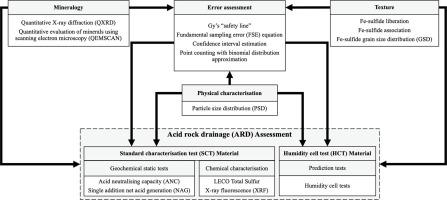Minerals Engineering ( IF 4.9 ) Pub Date : 2021-01-19 , DOI: 10.1016/j.mineng.2020.106750 Olga Guseva , Alexander K.B. Opitz , Jennifer L. Broadhurst , Susan T.L. Harrison , Megan Becker

|
The value of quantitative mineralogy and texture is often not fully appreciated within minerals applications, and particularly so in the analysis of acid rock drainage (ARD). This is partly due to the absence of a clear understanding as to why quantitative textural tools such as QEMSCAN are valuable for ARD assessment. Additionally, most ARD prediction work is performed on a coarse particle scale, for which statistical representativeness of quantitative textural and mineralogical data becomes difficult to achieve. The current study provides an application of mineralogical and textural data (Fe-sulfide liberation, association, grain size distribution) to geochemical characterisation and humidity cell tests and applies these data to the estimation of the fundamental sampling error (FSE) and mineralogical error through binomial distribution and confidence intervals for liberation data. For the ARD characterisation tests, the mineralogy was key in interpreting the classification of the samples as potentially acid forming, non-acid forming or uncertain. For ARD prediction tests, the large degree of Fe-sulfide encapsulation in intermediate weathering, slow weathering and inert minerals aided in understanding the circumneutral behaviour of potentially acid forming and uncertain samples after 60 weeks of the humidity cell testing. The particle size distribution, in conjunction with texture assessment, showed that ±50% of the Fe-sulfides were unliberated, leading to the expectation that reactivity in the humidity cells would occur predominantly as a result of mineral reaction in finer fractions. The evaluation of uncertainties suggested that “one size fits all” tools such as Gy’s safety line or the binominal distribution approximation may not be adequate in all cases, particularly for coarse material, such as that of the parent samples or humidity cell tests. In these situations, material-specific approaches for error consideration should be taken, which in this study were the calculation of the FSE for each sample, and the plotting of size-by-size confidence intervals for the Fe-sulfide liberation data.
中文翻译:

waste石中酸性岩石排水潜力的表征和预测:定量矿物学和组织学测量相结合的价值
在矿物应用中,尤其是在酸性岩石排泄(ARD)分析中,定量矿物学和质地的价值通常未得到充分认识。部分原因是由于缺乏对为什么QEMSCAN等定量纹理工具对于ARD评估有价值的清楚认识。此外,大多数ARD预测工作都是在粗粒度范围内进行的,因此很难实现定量结构和矿物数据的统计代表性。当前的研究提供了矿物学和组织学数据的应用(硫化铁的释放,缔合,粒度分布)用于地球化学表征和湿度单元测试,并将这些数据通过二项式分布和解放数据的置信区间应用于基本采样误差(FSE)和矿物学误差的估计。对于ARD表征测试,矿物学是将样品分类为潜在成酸,非成酸或不确定酸的关键。对于ARD预测测试,在中等耐候性,慢速耐候性和惰性矿物中大量的硫化铁包封有助于了解在经过60周的湿气测试后可能形成酸和不确定样品的环境行为。粒度分布结合织构评估表明,±50%的硫化铁未释放,导致人们期望湿度单元中的反应性主要是由于矿物质在更细小部分中的反应而产生的。不确定性评估表明,“一刀切”的工具(例如Gy的安全线)或二项式分布近似法可能无法在所有情况下都适用,特别是对于粗材料(例如母体样品或湿气箱测试)而言。在这种情况下,应采用考虑误差的材料特定方法,在本研究中,这是每个样品的FSE的计算,以及硫化铁释放数据的尺寸间置信区间的绘制。不确定性评估表明,“一刀切”的工具(例如Gy的安全线)或二项式分布近似法可能无法在所有情况下都适用,特别是对于粗材料(例如母体样品或湿气箱测试)而言。在这种情况下,应采用考虑误差的材料特定方法,在本研究中,这是每个样品的FSE的计算,以及硫化铁释放数据的尺寸间置信区间的绘制。不确定性评估表明,“一刀切”的工具(例如Gy的安全线)或二项式分布近似法可能无法在所有情况下都适用,特别是对于粗材料(例如母体样品或湿气箱测试)而言。在这种情况下,应采用考虑误差的材料特定方法,在本研究中,这是每个样品的FSE的计算,以及硫化铁释放数据的尺寸间置信区间的绘制。











































 京公网安备 11010802027423号
京公网安备 11010802027423号